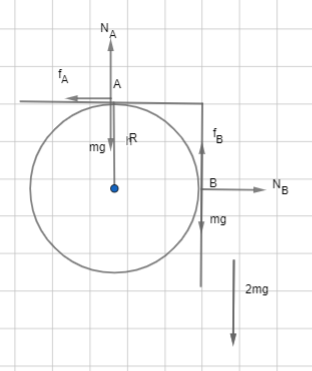
A rod bent at right angle along its centre line, is placed on a rough horizontal fixed cylinder of radius R as shown in the figure. Mass of the rod is 2m and the rod is in equilibrium. Assume that the friction force on rod at A and B is equal in magnitude

This question has multiple correct options
A. Normal force applied by cylinder on rod at A is $3mg/2$
B. Normal force applied by cylinder on rod at B must be zero
C. Friction force acting on rod at B is upward
D. Normal force applied by cylinder on rod at A is mg

Answer
588.3k+ views
Hint: Draw a free body diagram according to the question and show all the components of the force. Then equate all the force components and solve the equations to find the forces which are asked in the option and compare the results to see which option is true.
Complete step by step answer:
First we will draw the component of various forces at point A and B.

At point A we have the normal force, weight and the friction as ${{N}_{A}},mg,{{f}_{A}}$ respectively and point B we have the normal force, weight and the friction as ${{N}_{B}},mg,{{f}_{B}}$ respectively.
Now we have the total weight of the rod is 2mg. so, equating the downward weight with the upward forces we get,
\[{{N}_{A}}+{{f}_{B}}=2mg\text{ }\to \text{ 1}\]
Now comparing the horizontal forces, we get,
${{f}_{A}}={{N}_{B}}\text{ }\to \text{ 2}$
Now balancing the torque of the rod with respect to the centre, we can write,
$\begin{align}
& {{f}_{A}}R+{{f}_{B}}R=mgR \\
& {{f}_{A}}+{{f}_{B}}=mg\text{ }\to \text{ 3} \\
\end{align}$
Again, from the question we have that,
${{f}_{A}}={{f}_{B}}\text{ }\to \text{ 4}$
Now, comparing the equation 3 and equation 4, we get,
${{f}_{A}}={{f}_{B}}=\dfrac{mg}{2}$
Putting this value on equation 2, we get,
${{N}_{B}}=\dfrac{mg}{2}$
Again, from equation 1 we get,
${{N}_{A}}=\dfrac{3mg}{2}$
From these values, we can say that the normal force applied by the cylinder to the rod at point A is $\dfrac{3mg}{2}$. So, option A is true.
Normal force at point B is not zero. Option B is wrong.
Friction force on rod at point B is upward. Option C is correct.
Option D is wrong since normal force at A is $\dfrac{3mg}{2}$.
So, the correct options are (A), (C).
Note: The normal force to a body will not be always in the opposite direction to the weight of the body. The normal force will be in the opposite direction to the force the body puts on the surface it is in and is perpendicular to the surface.
Complete step by step answer:
First we will draw the component of various forces at point A and B.

At point A we have the normal force, weight and the friction as ${{N}_{A}},mg,{{f}_{A}}$ respectively and point B we have the normal force, weight and the friction as ${{N}_{B}},mg,{{f}_{B}}$ respectively.
Now we have the total weight of the rod is 2mg. so, equating the downward weight with the upward forces we get,
\[{{N}_{A}}+{{f}_{B}}=2mg\text{ }\to \text{ 1}\]
Now comparing the horizontal forces, we get,
${{f}_{A}}={{N}_{B}}\text{ }\to \text{ 2}$
Now balancing the torque of the rod with respect to the centre, we can write,
$\begin{align}
& {{f}_{A}}R+{{f}_{B}}R=mgR \\
& {{f}_{A}}+{{f}_{B}}=mg\text{ }\to \text{ 3} \\
\end{align}$
Again, from the question we have that,
${{f}_{A}}={{f}_{B}}\text{ }\to \text{ 4}$
Now, comparing the equation 3 and equation 4, we get,
${{f}_{A}}={{f}_{B}}=\dfrac{mg}{2}$
Putting this value on equation 2, we get,
${{N}_{B}}=\dfrac{mg}{2}$
Again, from equation 1 we get,
${{N}_{A}}=\dfrac{3mg}{2}$
From these values, we can say that the normal force applied by the cylinder to the rod at point A is $\dfrac{3mg}{2}$. So, option A is true.
Normal force at point B is not zero. Option B is wrong.
Friction force on rod at point B is upward. Option C is correct.
Option D is wrong since normal force at A is $\dfrac{3mg}{2}$.
So, the correct options are (A), (C).
Note: The normal force to a body will not be always in the opposite direction to the weight of the body. The normal force will be in the opposite direction to the force the body puts on the surface it is in and is perpendicular to the surface.
Recently Updated Pages
Why are manures considered better than fertilizers class 11 biology CBSE

Find the coordinates of the midpoint of the line segment class 11 maths CBSE

Distinguish between static friction limiting friction class 11 physics CBSE

The Chairman of the constituent Assembly was A Jawaharlal class 11 social science CBSE

The first National Commission on Labour NCL submitted class 11 social science CBSE

Number of all subshell of n + l 7 is A 4 B 5 C 6 D class 11 chemistry CBSE

Trending doubts
10 examples of friction in our daily life

One Metric ton is equal to kg A 10000 B 1000 C 100 class 11 physics CBSE

Difference Between Prokaryotic Cells and Eukaryotic Cells

1 Quintal is equal to a 110 kg b 10 kg c 100kg d 1000 class 11 physics CBSE

State the laws of reflection of light

Explain zero factorial class 11 maths CBSE




